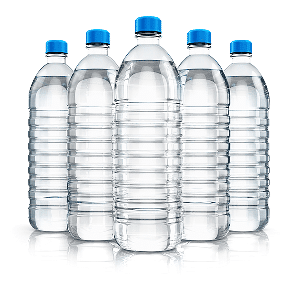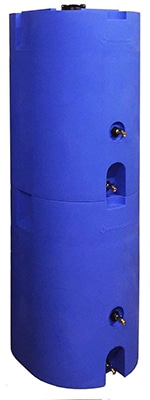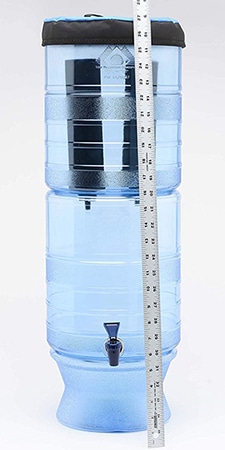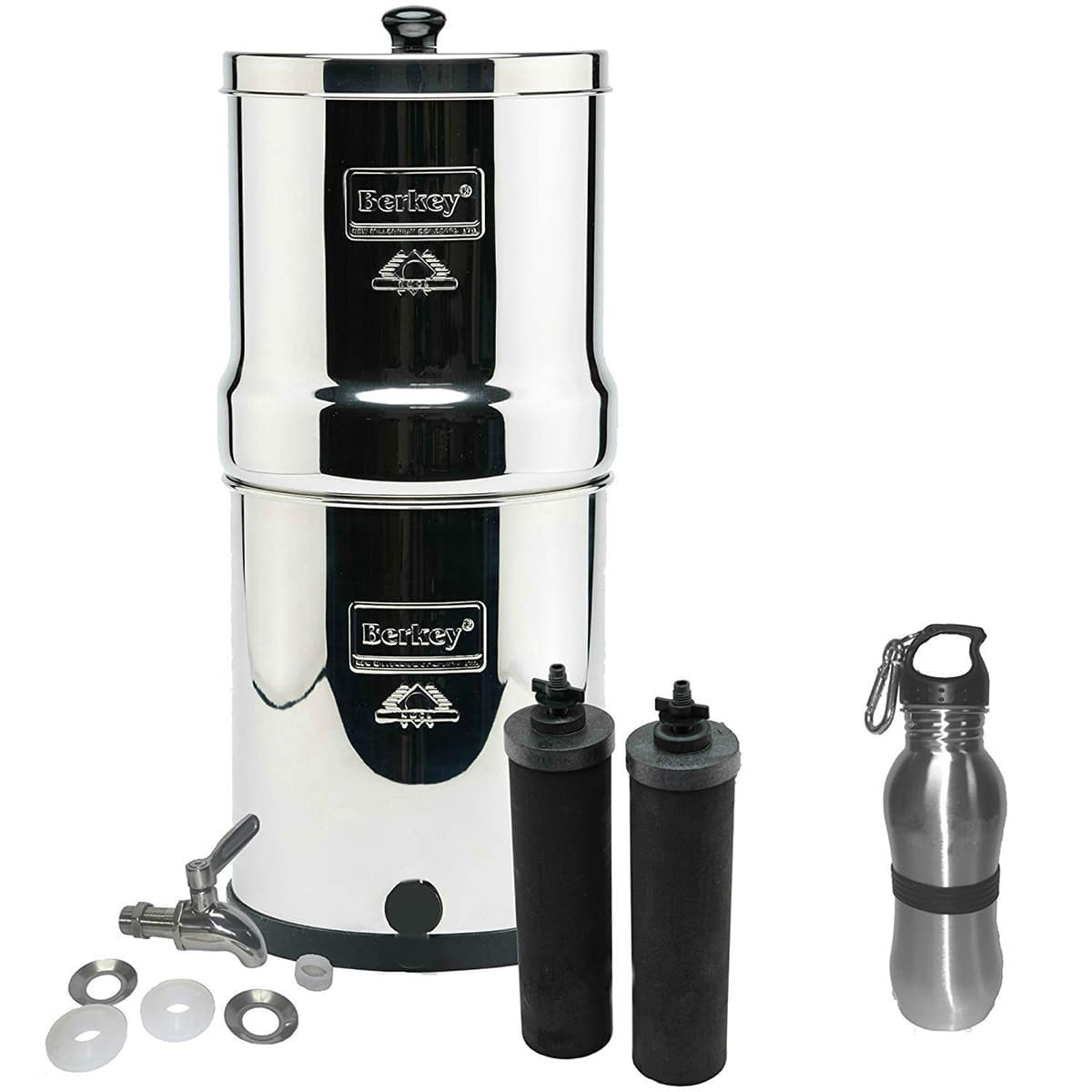Prepper Water Storage and Filtration – The Ultimate Guide

Of all the supplies you can stock up on in preparation for an emergency, none is more important than water. According to the rule of threes, you can survive up to 3 weeks without food, but just 3 days without water. The general guideline for the minimum amount of water you should have on hand is 1 gallon per person per day. That means, for example, that a two-week supply of water for a family of 4 would be a minimum of 56 gallons of water. Lasting longer than that will of course require you to store more.
Given water’s importance for survival, having a proper water supply is a fundamental part of prepping for when SHTF.
In this guide we’ll tell you everything you need to know about prepper water storage and water filtration. We’ll cover the basic ideas behind water storage, what water storage methods you should consider, and supplies you need for water filtration.
Water storage brings with it numerous challenges: Where do you store your water? How much of it do you store? What do you store it in? How will you make sure it is safe to drink, possibly after long-term storage? Thankfully, many of these basic questions can be answered through following a handful of simple guidelines.
1) Store Your Water in a Cool, Dark, Dry Place
The most basic rule of water storage is to store it in a cool, dark, dry place. This is in order to protect your water from the growth of bacteria or other microorganisms. Basements as well as cool garages can make good storage places. Alternatively, a closet or pantry can suffice assuming they are large enough.
2) Store Your Water in Large, Food-Grade, Non-Translucent Containers

The second fundamental of prepper water storage is to store your water in large, food-grade, non-translucent containers. Containers that are explicitly designed for water storage are made of food-grade polyethylene that will not release chemicals into your water over time. They are also blue, which blocks out almost all external light and discourages microorganism growth.
The size of your water containers is largely up to you. Larger containers will allow for longer-term supplies, but large containers are also more difficult to transport and store. For this reason we recommend you have a combination of large water containers (e.g. 55 gallon) as well as smaller, 5 gallon containers.
3) Keep Filters or Portable Stoves On-Hand to Purify Water After Long-Term Storage
Even with the above containers, some microorganism growth is likely to occur inside your water containers if they are left alone for long periods of time. For this reason, it is always important to keep multiple tools on hand with which you can purify your water.
Portable stoves are excellent options for boiling water, which will kill any microorganisms that may have grown while your water was in storage. Filters are also excellent options, and come with the added bonus that they do not require you to use any of the fuel for your stove, which will likely be in limited supply.
A note about purifying water before storing it: While we do recommend giving your storage containers a thorough cleaning and drying before storing water in them, it is generally unnecessary to purify the water itself prior to storage. Regular tap water in the United States has been filtered to a point where it is perfectly safe to drink, and by extension safe to store. We recommend that you always filter or boil your water if it has been in storage for a significant period of time. With that in mind, purifying it before storage would be redundant.
4) Think About Alternative Water Sources and Portable Containers
Depending on the storage space available in your home, along with the amount of money you are able to invest in prepping, you may not be able to keep as large of a water supply as you would like. Even a comparatively large water supply of 100 gallons will only last a family of four for 25 days. Survival beyond that will require you to make use of alternative water sources.
Rain catchers and water purification systems, for example, are a critical component of any prepper’s arsenal. These tools will allow you to continually replenish your water supply, instead of relying only on what you stored before SHTF.
Perhaps equally important, you should invest in a sufficient number of portable water containers as well. Camelbaks and Nalgene water bottles obviously will not be capable of storing as much water as a 55 gallon drum, but they may be your only option if, for whatever reason, you have to leave the bulk of your storage behind.
Now that we know the basics of water storage, we can discuss some of the prepper water storage options you should consider.
1) Bottles of Water
The easiest and most obvious addition to your prepper water supply is bottled water. In fact, buying a reasonably sized stock of bottled water is likely one of the first steps you should take as a prepper. Bottled water is included in your prepper water supply because it is affordable (compared to some of the longer-term storage options that follow), it can be bought at your neighborhood grocery store, and it is portable—an important feature should you ever need to bug out.
While not as long-lasting as some of the suggestions that follow, bottled water that is FDA approved and unopened lasts for 2 or more years. Given this shorter shelf life, we recommend you keep track of your water bottles’ expiration dates and use/replace them when the time comes.
It’s a good idea to keep some amount of bottled water on hand, but you will also want to invest in some alternative water storage methods that allow you to store greater quantities of water, for longer.
2) Reusable Water Containers
As stated earlier, bottled water’s limited shelf life means that it will only get you so far in a SHTF scenario. For this reason, we recommend that you also purchase one or more reusable storage containers specifically for water storage. Though these products do have a greater upfront cost than water bottles, reusable storage containers are more cost effective in the long run—considering they will not have to be regularly replaced.
Here are our picks for the best prepper water containers:
5 Gallon Stackable Water Storage Containers

5 gallon containers are perhaps the most flexible containers for water storage because they are large enough to store a significant amount of water, while also remaining somewhat portable. The above containers also possess the qualities described earlier in this guide as desirable in water storage options: they are made of thick, food grade polyethylene that blocks out most light—discouraging microorganism growth.
Amazon offers a kit of 4 5-gallon containers, 6 lids, 2 spigots, and 1 bottle of water preserver. You can also buy 4 containers without the additional accessories.
55 Gallon Water Storage Barrel

An alternative to the above option that costs about the same price, a 55 gallon drum will store almost 3 times as much water as the above kit. The trade-off, of course, is portability. This barrel will weigh over 400 lbs when completely full with water, making transporting it a significant challenge.
Note: This barrel also will require you to purchase a bung wrench and siphon pump to be able to easily access your water
The Water Bob

One of the easiest techniques to make use of in a SHTF scenario, is to fill up your bath tub with water in anticipation of a disaster. What this idea fails to take into account is the fact your tub is probably pretty gross!
The Water Bob allows you to store up to 100 gallons of water in your bathtub, without exposing it to the bacteria, scum, and harmful cleaning agents that have been used to clean your tub.
Obviously, this option would be nearly impossible to transport when full of water. With that said, it's a good idea for your home base.
160 Gallon Stackable Water Storage Tanks

For those preppers who want an especially long-term water supply, these stackable water tanks will provide you with 320 gallons worth of water storage. As you can imagine, they are very large, very heavy, and expensive. In fact, just one of these tanks weighs over a 1/2 ton when filled with water.
However, these tanks are excellent in terms of quantity of storage, assuming you have room to keep them somewhere and the budget to pay for them. Amazon sells 2 of these tanks in a bundle (the image shows two of them stacked).
These tanks also include a 330 gallon water storage treatment kit. Connector valves and spigots are built into the tanks, allowing you to connect any standard water hose.
If you're concerned about where these tanks can be stored, it's worth noting they should fit through a standard doorway. With that said, due to the weight of these when full, it's likely best to store these in a garage or basement if planning to keep them indoors.
High Capacity Water Storage Tanks
Finally, for those of you who want truly long-term water storage capabilities, there are high capacity water storage tanks. These tanks come in a variety of models that differ in their storage capacity as well as the material with which they are built. As mentioned earlier, for water, we recommend tanks made of food grade polyethylene.
High capacity tanks come in a huge range of sizes—the biggest we’ve seen is 20,000 gallons! Obviously higher capacity tanks will also be more expensive, so you’ll have to balance out size and cost to best fit your budget.

Storing all the water in the world won’t do you much good unless you can also ensure that it is safe to drink. For that reason, it is critical that you invest in water purification or filtration systems. A few things to consider when selecting a water filter are:
- Micron rating: This describes how small the pores are in a given water filter. Smaller pores means fewer contaminants will pass through.
- Contaminants: While not all filter companies will explicitly advertise their micron ratings, nearly all of them will tell you which contaminants a filter reliably eliminates. If you want maximum protection, you will want a filter that removes all microorganisms (bacteria, viruses, cysts, etc.) as well as chemicals and radiation. A handful of higher-end filters will even remove salt from seawater, which is a great feature.
- Size: Do you need to filter water for a whole family? How important is portability?
- Filter lifespan: All water filtration systems will need to have their filters replaced at some point. Some filter brands have longer lifespans than others.
- Cost: This one needs no explanation. One not-so-obvious cost factor to consider, however, is the cost of extra filters.
With those considerations in mind, here are some of our recommended water purification options:
1) The Best Portable Water Filters
Portable water filters are the perfect combination of convenience and efficiency. Our recommended filters will remove, at minimum, 99.999% of bacteria from contaminated water. Some models will provide you with even cleaner water by removing viruses, lead, chemicals, cysts, and even radiation.
The following is a table with some of our favorite portable water filters:
| Filter | Type of Filter | Removes Bacteria | Removes Viruses | Removes Lead | Removes Chemicals | Removes Radiation |
|---|---|---|---|---|---|---|
 Seychelle (RAD/ADV Bottle)
Seychelle (RAD/ADV Bottle) | Bottle | ✔ (99.9999%) | ✔ (99.9999%) | ✔ (99.9999%) | ✔ (99.9999%) | ✔ (99.9999%) |
 Pocket Pump 2 Pure (RAD-ADV-PH)
Pocket Pump 2 Pure (RAD-ADV-PH) | Pump | ✔ (99.9999%) | ✔ (99.9999%) | ✔ (99.9999%) | ✔ (99.9999%) | ✔ (99.9999%) |
 Survior Filter® PRO
Survior Filter® PRO | Pump | ✔ (99.999%) | ✔ (99.999%) | (93%) | ||
 Survior Filter® Squeeze Kit
Survior Filter® Squeeze Kit | Straw and Canteens | ✔ (99.999%) | ✔ (99.999%) | |||
 LifeStraw Flex
LifeStraw Flex | Bottle | ✔ (99.999%) |
The biggest shortcoming of portable water filters is obviously their small filtration capacity. If you need to filter large quantities of water, you’ll likely want to invest in some additional water filtration solutions.
2) Family-Sized Water Filtration Systems
Readers who are looking for a water filtration system fit for the whole family would do well to consider the Berkey Light Water Filtration System. The system consists of a 2.75 gallon tank and two filters, capable of filtering up to 6,000 gallons of water over the course of their lifespan. The Berkey Light will produce between 3.75 gallons (with 2 filters) and 7 gallons (with 4 filters) of purified water per hour, making it a more practical solution for those with high water demands.
Unfortunately, Berkey does not specify the Berkey Light’s filter size (in microns); however, the product is advertised to remove 99.99% of viruses and bacteria. The Berkey Light is also capable of removing chemicals and lead, though the efficacy is not specified.
Although family-sized filters are certainly bulkier than the portable filters listed above, the Berkey Light is great because it is still lightweight enough to be included in a bugout bag (5.6 lbs. when empty, around 30 lbs. when full).
If you want something with an even greater filtration capacity, Berkey makes water filtration systems in several larger sizes. The largest model, the Crown Berkey, has a 6 gallon storage capacity and can produce up to 26 gallons of purified water per hour.
Additional Berkey water filters can be purchased here.

3) LIFESAVER Jerrycan
Somewhere between a portable and a family-sized water filter lies the LIFESAVER jerrycan. This 5 gallon jug is capable of filtering over 5,000 gallons of water over the course of its lifespan, removing 99.999% of bacteria, viruses, and cysts. The LIFESAVER jerrycan also removes chemicals from water, though the manufacturer does not give a specific percentage.
The main shortcoming of the LIFESAVER jerrycan is its price, which is about the same cost of the Berkey Light. But if you value the LIFESAVER’s unique combination of portability and mid-range storage capacity, it could be a good fit for you.
4) Desalinators
If you’re someone who lives near the coast, you might be interested in picking up a desalinator—a device that can filter the salt out of sea water to make it safe for human consumption. Desalinators are great because, assuming you have access to the ocean and a sufficient number of replacement filters, they will give you a near-infinite supply of water.
If that sounds appealing to you, we’d recommend you look at the GRAVI-STIL Emergency Survival Distiller and Gravity Filter Combination, which combines top of the line water filtration with desalination capabilities. The GRAVI-STIL comes with a 0.2 Micron Candle Ceramic Water Filter capable of removing nearly 100 percent of water contaminants, including microorganisms, heavy metals, chemicals, radiation, and even salt.
Perhaps the only drawback of the GRAVI-STIL is its above-average price tag. That being said, the price seems fair for what you’re getting.

5) Chemical Water Purifiers
Finally, we have chemical water purifiers, which can be an effective means of killing microorganisms that may be present in your water. The most noteworthy chemicals for this purpose are bleach and water purification tablets.
According to the EPA, water can be cleaned with bleach by using a clean dropper to mix in very small amounts of bleach to your water supply (see table below). Simply drop in the appropriate amount, mix it in, and let the water stand for 30 minutes. One important thing to note: it is critical to only use regular, unscented chlorine bleach—other bleach products can be toxic.

